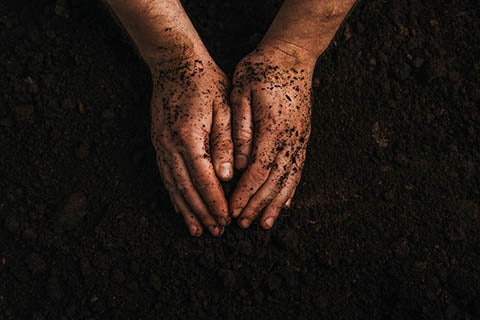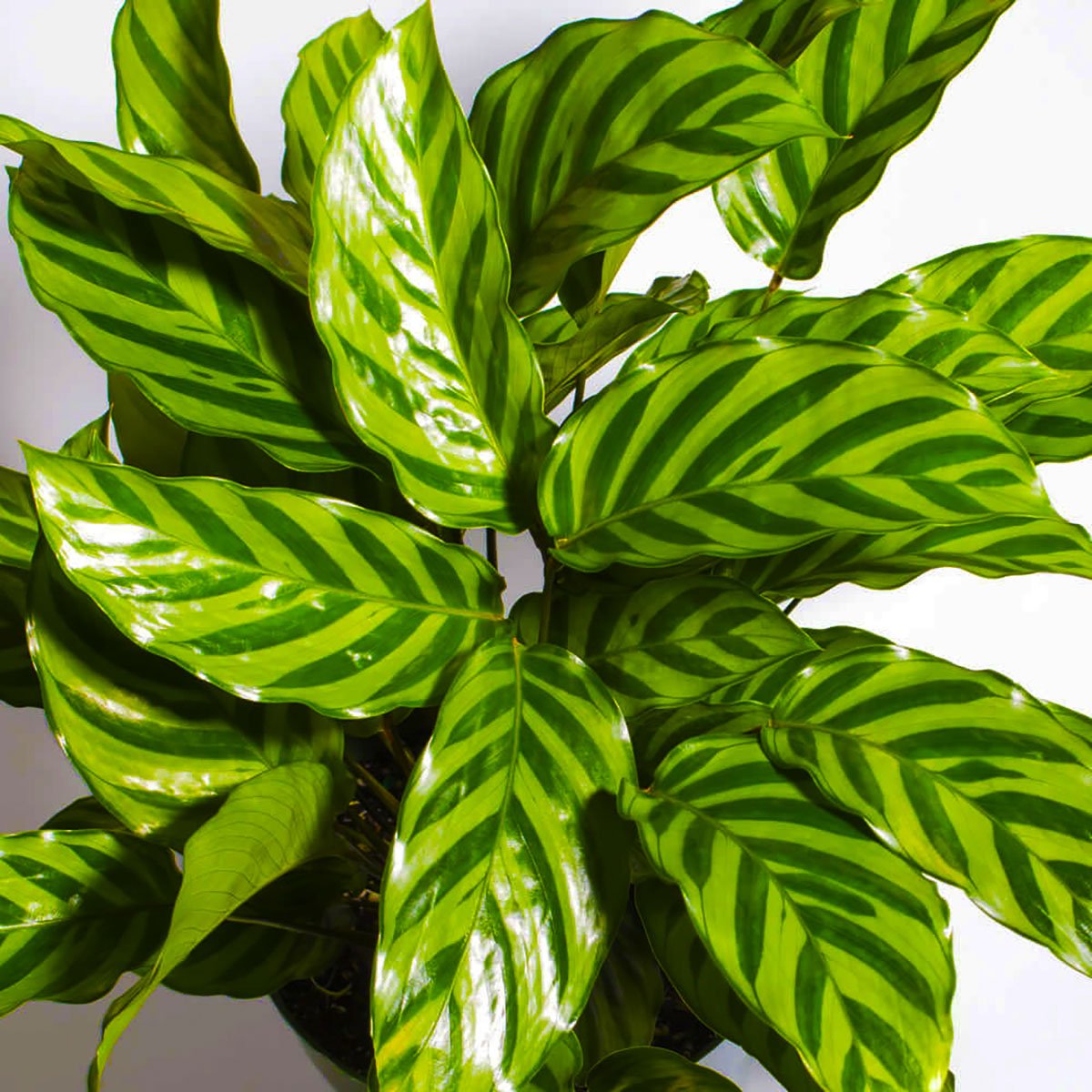
If you're looking for a stunning, medium-maintenance houseplant that adds a touch of tropical flair to your indoor space, look no further than the Calathea Concinna 'Freddie'. With its vibrant green leaves, striking patterns, and gorgeous nature, this beautiful plant is a popular choice for average and experienced plant owners alike.
In this care guide, we'll take a closer look at the Calathea Concinna 'Freddie' and provide you with everything you need to know to keep your plant healthy, thriving, and looking its best. From lighting and watering to fertilization and pest control, we'll cover all the basics so you can enjoy your Calathea Concinna 'Freddie' for years to come.
So whether you're a seasoned plant parent or just starting out on your green journey, keep reading to learn more about this stunning plant and how to care for it like a pro.

What is the Light Requirement for a Calathea Freddie?
This plant prefers bright, indirect light but can tolerate low light conditions as well. Direct sunlight can scorch the leaves, so it's best to avoid placing your plant in direct sunlight.
If you're not sure if your Calathea Concinna 'Freddie' is getting enough light, here's a quick tip:
If the leaves are curling or fading in color, it may be a sign that your plant needs more light. On the other hand, if the leaves are turning yellow or brown, it may be getting too much light.
To provide your Calathea Concinna 'Freddie' with the ideal lighting conditions, consider placing it near a north or east-facing window where it can receive bright, indirect light.
You can also use a sheer curtain or a shade cloth to filter the light and protect the leaves from direct sunlight.

Humidity and Temperature Requirements
The Calathea Concinna 'Freddie' is native to tropical regions and prefers high humidity and warm temperatures similar to its natural habitat.
To ensure that your plant thrives, it's important to provide it with the right humidity and temperature conditions.
Humidity: Thrives in high humidity levels between 60-80%.
If the air in your home is dry, you can increase the humidity around your plant by misting it with a spray bottle of water, placing a humidifier nearby, or placing a tray of water near the plant to evaporate and create moisture in the air.
Be sure to avoid letting the plant sit in standing water or overly wet soil, as this can lead to root rot.
Temperature: The ideal temperature range is between 65-80°F (18-27°C). Keep your plant away from cold drafts or hot, dry air sources like vents or radiators, as this can damage the leaves or cause them to dry out.
In summary, keeping the humidity high and the temperature warm will help your Calathea thrive and stay healthy.

How often should I water Calathea Freddie?
Proper watering is essential to keep 'Freddie' healthy and thriving. However, it's important to note that overwatering or underwatering can lead to issues like root rot or yellowing leaves.
The frequency of watering will depend on several factors such as the size of the pot, the type of soil, the level of humidity, and the amount of light your plant receives.
In general, it's best to allow the top inch of soil to dry out slightly between watering.
As a rule of thumb, you can water your Calathea once a week and adjust the frequency as needed.
To check if your plant needs water, insert your finger into the soil about an inch deep. If it feels dry, it's time to water.
If the soil feels moist or wet, wait a few more days before watering.
It's important to use room temperature, filtered water when watering your Calathea Concinna , as this will help prevent any potential shock or damage to the roots.
Additionally, make sure to water the soil directly and avoid getting water on the leaves, as this can cause spotting or damage.

Soil requirement for Calathea Freddie
'Freddie' prefers well-draining soil that retains moisture but does not become waterlogged.
A good potting mix for Calathea Concinna 'Freddie' should be light, airy, and rich in organic matter to provide nutrients and improve soil structure.
You can create a suitable potting mix by combining equal parts of peat moss, perlite, and vermiculite.
This mix will help retain moisture while also allowing excess water to drain away, preventing the soil from becoming waterlogged.
When repotting your Calathea Concinna 'Freddie', choose a pot that is one size larger than its current pot and make sure it has drainage holes to allow excess water to escape.
Before planting, ensure that the potting mix is moist but not overly wet.

Pruning and Maintenance of Calathea Freddie
Pruning and regular maintenance are important to keep your Calathea 'Freddie' healthy and looking its best. Here are some tips I use for pruning and maintaining my Calathea:
-
Remove dead or yellowing leaves: As with any plant, removing any dead or yellowing leaves is important to prevent the spread of disease and to keep the plant looking neat and tidy. Use clean, sharp scissors to remove any damaged or discolored leaves at their base.
-
Prune for shape: If your 'Freddie' starts to become leggy or loses its shape, you can prune it to encourage bushier growth. Use sharp scissors or pruning shears to trim back any overgrown stems, taking care to maintain the overall shape of the plant.
-
Clean the leaves: Calathea leaves are prone to dust and debris buildup, which can affect the plant's ability to absorb light. To keep the leaves clean, wipe them gently with a damp cloth or sponge. Avoid using any cleaning products or chemicals that can damage the leaves.
-
Repotting: Calathea Concinna should be repotted every 1-2 years to prevent the plant from becoming rootbound. When repotting, choose a pot that is one size larger than the current pot and use a well-draining potting mix.
-
Maintain ideal growing conditions: In addition to pruning and cleaning, it's important to maintain the ideal growing conditions for your Calathea Concinna. This includes providing bright, indirect light, high humidity, and keeping the soil moist but not waterlogged. Avoid exposing the plant to cold drafts or hot, dry air, as this can damage the leaves.

Does the Calathea Freddie require fertilization?
The answer is yes. ‘Freddie’ benefits from regular fertilization during the growing season (spring and summer).
Fertilization provides the plant with essential nutrients necessary for growth, vibrant foliage, and flowering (if applicable).
You can use a balanced, water-soluble fertilizer with an NPK (Nitrogen Phosphorus Potash) ratio of 10-10-10 or 20-20-20, diluted to half strength.
Apply the fertilizer every 2-4 weeks, following the manufacturer's instructions for application rates.
It's important not to over-fertilize 'Freddie', as this can lead to salt build-up in the soil, which can damage the roots and cause yellowing or brown leaves.
Always dilute the fertilizer and avoid getting it on the leaves, as this can cause burning or damage.
During the dormant season (fall and winter), reduce or stop fertilization, as the plant is not actively growing and doesn't require as many nutrients.

Propagation of Calathea Freddie
'Freddie' can be propagated by division, which involves separating the plant into smaller sections and planting them in separate containers. Here's how to propagate 'Freddie':
-
Select a healthy, mature plant with several stems or "clumps" growing from the soil.
-
Carefully remove the plant from its pot and gently separate the clumps by teasing apart the roots. Be careful not to damage the roots or the stems.
-
Once the clumps are separated, select the healthiest ones with a good root system and at least one stem.
-
Pot each clump into a separate container using a well-draining potting mix. Water the soil thoroughly and place the new plants in a bright, indirect light location.
-
Keep the soil moist, but not overly wet, and maintain high humidity around the new plants to help them establish new roots. Cover the new plant with a plastic bag or place a clear plastic dome over the pot to help maintain humidity.
-
After a few weeks, the new plants should start to grow new leaves and roots. Once they have been established, you can remove the plastic bag or dome and care for them as you would a mature Calathea.
Propagation by division is the easiest and most reliable way to propagate Calathea. It's best to do this during the growing season, when the plant is actively growing and can recover more quickly from the stress of being divided.

Is Calathea Freddie Toxic?
Calathea Concinna 'Freddie' is not considered toxic to humans or pets, according to the American Society for the Prevention of Cruelty to Animals (ASPCA).
This makes it a safe plant to have in homes with pets or children, although it's always a good idea to keep any plant out of reach of curious pets or children who might ingest it.
However, it's worth noting that 'Freddie' is still a living plant and can cause irritation or allergies in some people if they come into contact with its leaves or sap.
If you have sensitive skin or allergies, it's a good idea to wear gloves when handling the plant or avoid touching it altogether.
If you have pets or children that like to chew on plants, it's always best to lean towards the side of caution and keep your Calathea out of reach or in an area that is inaccessible to them.

Diseases and Pests and Common Queries
Calathea Concinna 'Freddie' is a relatively hardy plant, but it can still be susceptible to a few pests and diseases. Here are some common issues that you may encounter with your Calathea and how to deal with them:
-
Spider mites: These tiny pests can infest the leaves of your plant, causing yellowing, curling, and a fine webbing on the undersides of the leaves. To treat spider mites, wash the plant with a strong spray of water to knock off the mites and their webs. You can also use an insecticidal soap or neem oil to treat the plant.
-
Mealybugs: These soft-bodied insects can be found on the stems and undersides of the leaves of your plant, causing damage and feeding on its sap. To treat mealybugs, remove them manually with a cotton swab dipped in rubbing alcohol. You can also use insecticidal soap or neem oil to treat the plant.
-
Root rot: Overwatering or poor drainage can cause root rot, which can be identified by brown, mushy roots and yellowing leaves. To treat root rot, remove the plant from its pot, trim away any damaged roots, and repot the plant in fresh soil with better drainage.
-
Leaf curling or browning: This can be caused by low humidity, cold drafts, or underwatering. Ensure the plant is in a warm, humid location away from direct sunlight and drafts, and water it regularly.
Common queries about Calathea Concinna 'Freddie':
-
Why are the leaves of my Calathea Concinna 'Freddie' turning yellow? Yellowing leaves can be caused by overwatering, underwatering, low humidity, or pests. Check the soil moisture, humidity levels, and inspect the plant for pests to determine the cause and adjust your care accordingly.
-
Why are the leaves of my Calathea Concinna 'Freddie' curling? Curling leaves can be caused by low humidity, cold drafts, or underwatering. Ensure the plant is in a warm, humid location away from direct sunlight and drafts, and water it regularly.
-
Can I prune my Calathea Concinna 'Freddie'? Yes, you can prune your Calathea Concinna 'Freddie' to remove any yellowing or damaged leaves. Use a clean, sharp pair of scissors or pruning shears to make a clean cut just above the base of the leaf stem.
-
Why is my Calathea Concinna 'Freddie' not flowering? Calathea Concinna 'Freddie' is not known for its flowers, and it is unlikely to bloom indoors. If you are providing it with appropriate care and conditions and it is still not flowering, it may not be mature enough to bloom or may not be a variety that blooms.
If you have any concerns about your Calathea Freddie, it's always best to consult a professional horticulturist or us here at Ethereal Company.
We hope this guide has been helpful in providing you with the knowledge and tips needed to care for your Calathea Freddie. Remember, this plant may require a little extra attention, but with the right care, it can thrive and bring beauty to your indoor or outdoor space.
If you're interested in learning more about caring for other plants, be sure to check out our other care guides. We are always here to help you with your plant care needs, and we wish you the best of luck in your journey to becoming a successful plant parent!
Shop all > Calatheas < here!


